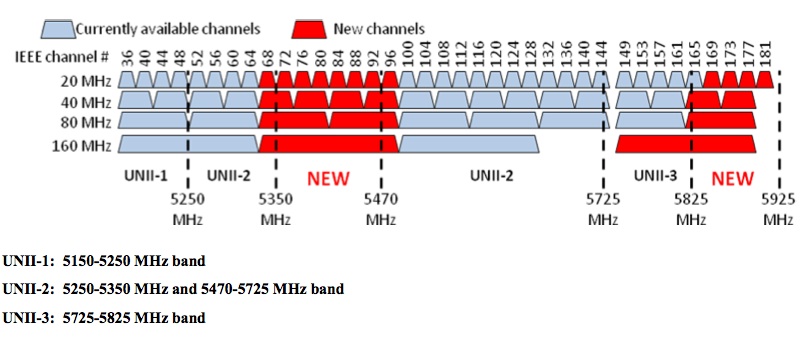At its February 20 meeting, the FCC will likely adopt a Notice of Proposed Rulemaking as a first step toward increasing the amount of spectrum available in the 5 GHz band for unlicensed devices. Up to 195 MHz might be made available, which is a 35% increase over the present 555 MHz. Chairman Genachowski announced this initiative at CES in January. A leading application for new spectrum would be IEEE 802.11ac, which could have four instead of the current two 160 MHz-wide channels.
A key point from the FCC news release on Genachowski announcement is that because the 5 GHz band is now used by various federal radio systems, the FCC’s effort will require “significant collaboration” with federal agencies. For it’s part, NTIA, administrator of federal spectrum, recently reported on its initial study on making that 195 MHz available. One of its main conclusions is that more study is needed, which it will do, planning to release its findings to the FCC in December 2014. So, we’re probably looking at 2015 — if things don’t slide too much — before new rules are issued by the FCC.
NTIA is taking the position that new 5 GHz users have to work around existing federal systems. It expects that current 5 GHz sharing technologies, that will allow federal and non-federal users to coexist, will be a necessary part of expanded users. These include transmitter power control (TPC) and dynamic frequency selection (DFS). A big concern here is protection of radar; an “insidious” scenario NTIA raises is that of a radar operator not seeing a target because of interference from an unlicensed device, and not realizing interference is being received.
NTIA will also look at other spectrum-sharing approaches, such as methods employing sensing, beacons, and geo-location database methods. NTIA suggests that current 5 GHz coexistence approaches may be insufficient and says “new safeguards” may be needed; for example, it says current protection techniques did not contemplate airborne signals, such as from drones. Moreover, NTIA anticipates an expanding role for federal systems, including for homeland security.
This language sounds familiar. A year ago NTIA released an unenthusiastic report on the viability of accommodating wireless broadband in the 1755-1850 MHz federal band. What happened in the preparation of that report is what I fear may happen here: NTIA might again rely on self-reporting by federal agencies as to their spectrum requirements, and no one will make an independent check. NTIA at least says says it will lead “detailed quantitative studies” and involve federal and non-federal stakeholders, including industry. It also says it will involve the intelligent transportation community; representatives of that community recently wrote the FCC asking that it, basically, not decide anything until the technical work is done.
Coincidental with all this, DARPA is starting a program that will look at sharing between military and commercial users, with radar called out specifically for study; it’s not clear now how applicable or timely DARPA’s results will be to NTIA’s or the FCC’s work.
